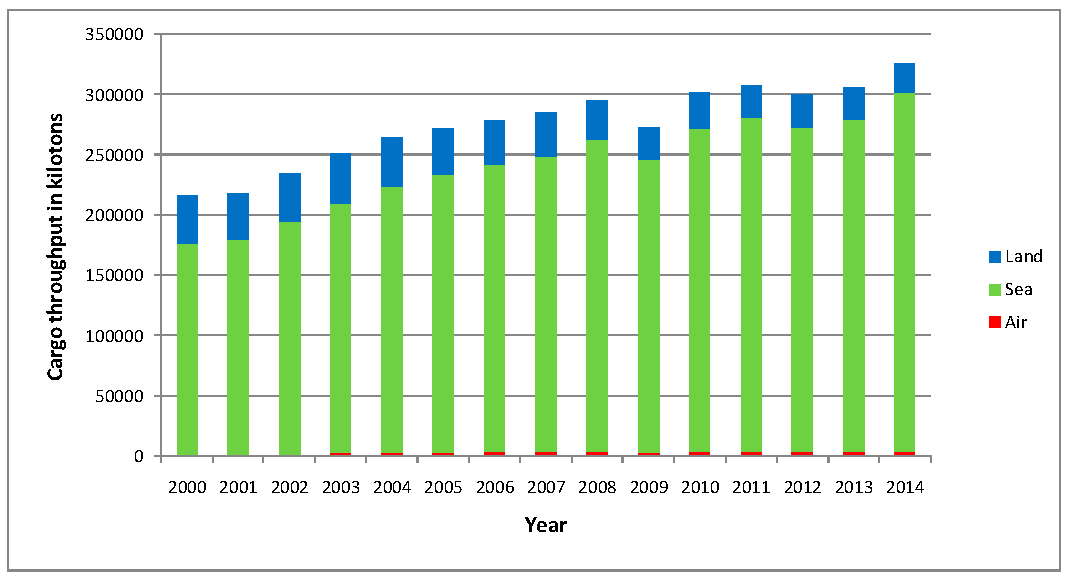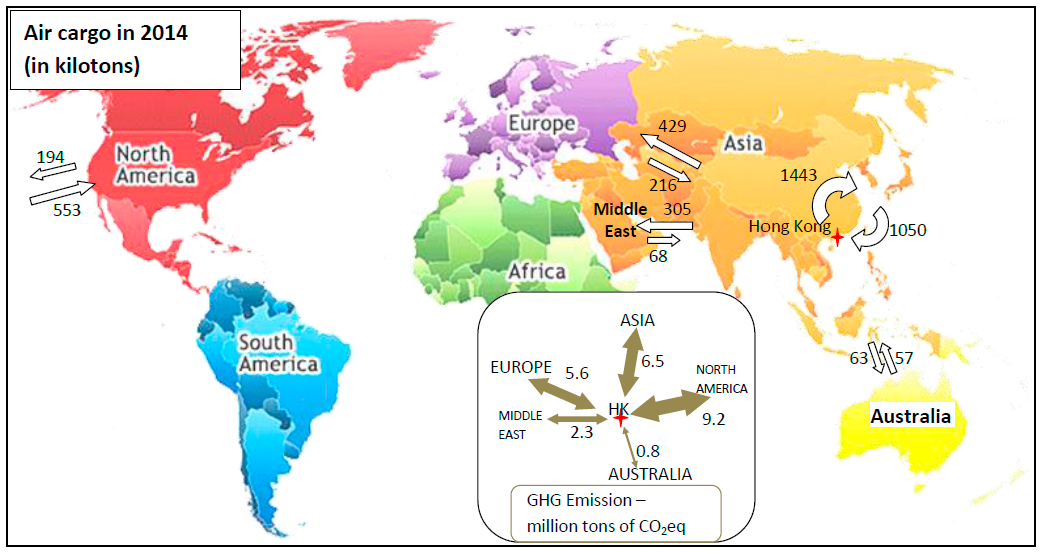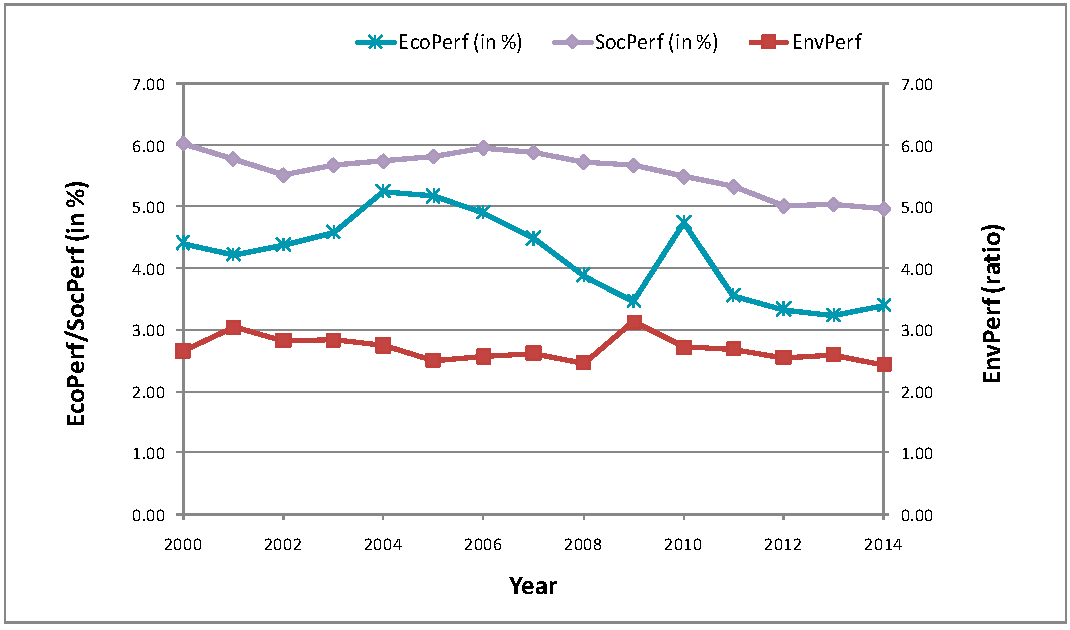A Triple Bottom Line Analysis of Hong Kong’s Logistics Sector
Abstract
:1. Introduction
2. Materials and Methods
2.1. Data Collection
2.2. Normalized Sustainability Indicators
3. Results
4. Discussion
5. Conclusions
Acknowledgments
Author Contributions
Conflicts of Interest
References
- Arvis, J.; Saslavsky, D.; Ojala, L.; Shepherd, B.; Busch, C.; Raj, A. Connecting to Compete 2014: Trade Logistics in the Global Economy; The World Bank: Washington, DC, USA, 2014; pp. 1–3. [Google Scholar]
- Dai, Y.; Gao, H.O. Energy consumption in China’s logistics industry: A decomposition analysis using the LMDI approach. Transp. Res. Part D Trans. Environ. 2016, 46, 69–80. [Google Scholar] [CrossRef]
- Grant, D.B.; Trautrims, A.; Wong, C.Y. Sustainable Logistics and Supply Chain Management; KoganPage: London, UK, 2015; pp. 16–27. [Google Scholar]
- Faccio, M.; Gamberi, M. New city logistics paradigm: From the “last mile” to the “last 50 miles” sustainable distribution. Sustainability 2015, 7, 14873–14894. [Google Scholar] [CrossRef]
- Klumpp, M. To green or not to green: A political, economic and social analysis for the past failure of green logistics. Sustainability 2016, 8, 441. [Google Scholar] [CrossRef]
- Abbasi, M.; Nilsson, F. Developing environmentally sustainable logistics: Exploring themes and challenges from a logistics service providers’ perspective. Transp. Res. Part D Transp. Environ. 2016, 46, 273–283. [Google Scholar] [CrossRef]
- Zachary, D.S. On the sustainability of an activity. Sci. Rep. 2014, 4, 5215. [Google Scholar] [CrossRef] [PubMed]
- Fauzi, H.; Svensson, G.; Rahman, A.A. “Triple bottom line” as “sustainable corporate performance”: A proposition for the future. Sustainability 2010, 2, 1345–1360. [Google Scholar] [CrossRef]
- Kuhlman, T.; Farrington, J. What is sustainability? Sustainability 2010, 2, 3436–3448. [Google Scholar] [CrossRef]
- Miller, P.; de Barros, A.G.; Kattan, L.; Wirasinghe, S.C. Analyzing the sustainability performance of public transit. Transp. Res. Part D Transp. Environ. 2016, 44, 177–198. [Google Scholar] [CrossRef]
- Lee, J.S.; Kim, S.K.; Lee, S.Y. Sustainable supply chain capabilities: Accumulation, strategic types and performance. Sustainability 2016, 8, 503. [Google Scholar] [CrossRef]
- Rodger, J.A.; George, J.A. Triple bottom line accounting for optimizing natural gas sustainability: A statistical linear programming fuzzy ILOWA optimized sustainment model approach to reducing supply chain global cybersecurity vulnerability through information and communications technology. J. Clean. Prod. 2017, 142, 1931–1949. [Google Scholar]
- The World Bank. Transport; The World Bank: Washington, DC, USA, 2016; Available online: http://www.worldbank.org/en/topic/transport (accessed on 1 December 2016).
- Hong Kong International Airport. Air Cargo; Hong Kong International Airport: Hong Kong, China, 2016; Available online: http://www.hongkongairport.com/eng/business/about-the-airport/air-cargo/air-cargo-intro.html (accessed on 1 December 2016).
- Hong Kong Marine Department. Ranking of Container Ports of the World; Hong Kong Marine Department: Hong Kong, China, 2016. Available online: http://www.mardep.gov.hk/en/publication/pdf/portstat_2_y_b5.pdf (accessed on 1 December 2016).
- Sikdar, S.K. Sustainable development and sustainability metrics. AIChE J. 2003, 49, 1928–1932. [Google Scholar] [CrossRef]
- Graubner, C.A.; Pelzeter, A.; Pohl, S. A new approach to measure sustainability in German facility management. Facilities 2016, 34, 28–42. [Google Scholar] [CrossRef]
- Landerretche, O.; Leiva, B.; Vivanco, D.; López, I. Welcoming uncertainty: A probabilistic approach to measure sustainability. Ecol. Indic. 2017, 72, 586–596. [Google Scholar] [CrossRef]
- Mickwitz, P.; Melanen, M. The role of co-operation between academia and policymakers for the development and use of sustainability indicators–a case from the Finnish Kymenlaakso Region. J. Clean. Prod. 2009, 17, 1086–1100. [Google Scholar] [CrossRef]
- Finkbeiner, M.; Schau, E.M.; Lehmann, A.; Traverso, M. Towards life cycle sustainability assessment. Sustainability 2010, 2, 3309–3322. [Google Scholar] [CrossRef]
- Beames, A.; Broekx, S.; Lookman, R.; Touchant, K.; Seuntjens, P. Sustainability appraisal tools for soil and groundwater remediation: How is the choice of remediation alternative influenced by different sets of sustainability indicators and tool structures? Sci. Total Environ. 2014, 470–471, 954–966. [Google Scholar] [CrossRef] [PubMed]
- To, W.M. Greenhouse gases emissions from the logistics sector: The case of Hong Kong, China. J. Clean. Prod. 2015, 103, 658–664. [Google Scholar] [CrossRef]
- Clift, R.; Wright, L. Relationships between environmental impacts and added value along the supply chain. Technol. Forecast. Soc. Chang. 2000, 65, 281–295. [Google Scholar] [CrossRef]
- US. Department of Commerce. Social Indicators 1973; U.S. Department of Commerce: Washington, DC, USA, 1973.
- Noll, H.H. Social indicators and Quality of Life research: Background, achievements and current trends. In Advances in Sociological Knowledge; Genov, N., Ed.; Springer Fachmedien Wiesbaden GmbH: Wiesbaden, Germany, 2004; pp. 151–181. [Google Scholar]
- Hong Kong Census and Statistics Department. The Hong Kong Annual Digest of Statistics; Hong Kong Census and Statistics Department: Hong Kong, China, 2016.
- Hong Kong Census and Statistics Department. The Four Key Industries and Other Selected Industries in the Hong Kong Economy; Hong Kong Census and Statistics Department: Hong Kong, China, 2016.
- Eggleston, S.; Buendia, L.; Miwa, K.; Ngara, T.; Tanabe, K. (Eds.) 2006 IPCC Guidelines for National Greenhouse Gas Inventories, Volume 2—Energy; Institute for Global Environmental Strategies for the Intergovernmental Panel on Climate Change: Kanagawa, Japan, 2006; pp. 8–68. Available online http://www.ipcc-nggip.iges.or.jp/public/2006gl/vol2.html (accessed on 1 December 2016).
- HKTDC Research. Air Transport Industry in Hong Kong; HKTDC Research: Hong Kong, China, 2016; Available online: http://hong-kong-economy-research.hktdc.com/business-news/article/Hong-Kong-Industry-Profiles/Air-Transport-Industry-in-Hong-Kong/hkip/en/1/1X000000/1X0018JT.htm (accessed on 1 December 2016).
- To, W.M. Association between energy use and poor visibility in Hong Kong SAR, China. Energy 2014, 68, 2–20. [Google Scholar] [CrossRef]
- Levine, B.S.; Gao, H.O. Aircraft taxi-out emissions at congested hub airports and implications for aviation emissions reduction in the United States. In Proceedings of the Transportation Research Board 86th Annual Meeting, Washington, DC, USA, 21–25 January 2007.
- Chia, S.Y. ASEAN economic integration and physical connectivity. Asian Econ. Pap. 2016, 15, 198–215. [Google Scholar] [CrossRef]
- Koliba, C.; Wiltshire, S.; Scheinert, S.; Turner, D.; Zia, A.; Campbell, E. The critical role of information sharing to the value proposition of a food systems network. Public Manag. Rev. 2017, 19, 284–304. [Google Scholar] [CrossRef]




| Cargo from (kT) | Cargo to (kT) | Dist. (km) | CO2–eq (kT) | |||
|---|---|---|---|---|---|---|
| Asia | 151,400 | 93731 | ||||
| Shanghai | 40,753 | 9922 | 1461 | 896 | ||
| Guangzhou | 53,517 | 45,064 | 152 | 181 | ||
| Taiwan | 7188 | 4172 | 872 | 120 | ||
| Japan | 10,129 | 5033 | 2961 | 543 | ||
| Singapore | 7991 | 2385 | 2630 | 330 | ||
| Korea | 5459 | 2425 | 2271 | 217 | ||
| others | 26,363 | 24,730 | 1461 | 903 | ||
| North America | 12,014 | 7288 | ||||
| Canada | 1986 | 1277 | 10,673 | 421 | ||
| USA | 10,028 | 6011 | 11,747 | 2280 | ||
| Europe | 8610 | 3894 | ||||
| Germany | 1818 | 907 | 18,390 | 606 | ||
| Netherlands | 1108 | 833 | 18,103 | 425 | ||
| UK | 1055 | 563 | 17,564 | 344 | ||
| others | 4629 | 1591 | 18,390 | 1384 | ||
| Cent. and South Am. | 5932 | 4327 | 19,878 | 2468 | ||
| Australia | 2550 | 1785 | 8943 | 469 | ||
| Africa | 1499 | 1125 | 12,014 | 382 | ||
| Mid East | 1315 | 1106 | 9303 | 273 | ||
| East Europe | 865 | 296 | 14,829 | 208 | ||
| Total: | 184,185 | 113,552 | 12,450 | |||
| Cargo from (kT) | Cargo to (kT) | Dist. (km) | CO2–eq (kT) | |
|---|---|---|---|---|
| Asia | 1050 | 1443 | 2763 | 6544 |
| North America | 194 | 553 | 12,993 | 9220 |
| Europe | 216 | 429 | 9116 | 5586 |
| Mid East | 68 | 305 | 6358 | 2253 |
| Australia | 57 | 63 | 7349 | 838 |
| Total: | 1585 | 2793 | 24,441 |
| Cargo from (kT) | Cargo to (kT) | Dist. (km) | CO2–eq (kT) | |
|---|---|---|---|---|
| Shenzhen | 8471 | 4991 | 100 | 161 |
| Dongguan | 4025 | 2546 | 180 | 142 |
| Guangzhou | 811 | 441 | 250 | 37 |
| Huizhou | 766 | 634 | 250 | 42 |
| others | 946 | 579 | 250 | 46 |
| 15,019 | 9191 | 428 |
| Fuel | Consumption | Calorific Value | Emission Factor CO2–eq (kT/TJ) | CO2–eq (kT) |
|---|---|---|---|---|
| Aviation gasoline | 6,959,479 kl | 0.0330 TJ/kl | 0.0715 | 16,421 |
| Motor gasoline | 497,730 kl | 0.0342 TJ/kl | 0.0693 | 1180 |
| Gas oil, diesel oil | 4,090,929 kl | 0.0386 TJ/kl | 0.0741 | 11,701 |
| Fuel oil | 6,309,426 kl | 0.0397 TJ/kl | 0.0774 | 19,387 |
| Liquefied petroleum gas | 398,240 T | 0.0496 TJ/T | 0.0631 | 1246 |
| Natural gas | 1,872,188 T | 0.0544 TJ/T | 0.0561 | 5714 |
| Coal | 13,795,832 T | 0.0264 TJ/T | 0.0964 | 35,110 |
| Total: | 90,759 |
© 2017 by the authors. Licensee MDPI, Basel, Switzerland. This article is an open access article distributed under the terms and conditions of the Creative Commons Attribution (CC BY) license ( http://creativecommons.org/licenses/by/4.0/).
Share and Cite
To, W.-M.; Lee, P.K.C. A Triple Bottom Line Analysis of Hong Kong’s Logistics Sector. Sustainability 2017, 9, 388. https://doi.org/10.3390/su9030388
To W-M, Lee PKC. A Triple Bottom Line Analysis of Hong Kong’s Logistics Sector. Sustainability. 2017; 9(3):388. https://doi.org/10.3390/su9030388
Chicago/Turabian StyleTo, Wai-Ming, and Peter K. C. Lee. 2017. "A Triple Bottom Line Analysis of Hong Kong’s Logistics Sector" Sustainability 9, no. 3: 388. https://doi.org/10.3390/su9030388






